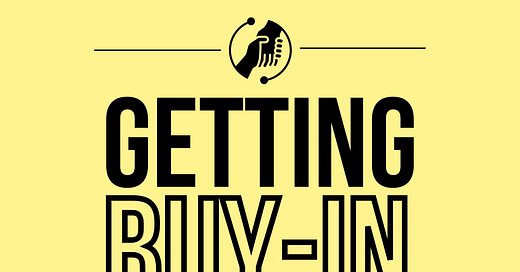TCW #049 | Getting buy-in for your ideas
Craft coalitions, win supporters, and give your ideas their best shot at succeeding, even in large bureaucratic organizations.
Hey, it’s 📣 Coach Erika! Welcome to a 🙏 paid subscriber edition🙏 of The Career Whispers. Each week, I tackle reader questions about tech careers: how to get one, how to navigate them, and how to grow and thrive in your role.
Not a subscriber? Here’s what you missed this month:
2 quotes to tickle your work mindset (for the new year)
Subscribe to The Career Whispers to access these posts and every future post.
Q: How can I sell my work internally and build coalitions around my projects to garner support?
Getting buy-in, resources, and support for new ideas is downright brutal in most companies. And if you agree, you’re not alone. This question is one of the top 5 concerns I hear from clients who are struggling to thrive at work.
Some examples of what it sounds like to struggle for buy-in:
“I went from a small, efficient organization into a large organization where it’s much harder to earn approval to move forward with my ideas.”
“I got used to trust-based relationships where I had built enough cache to green-light most of my ideas — and then something changed.”
“I just switched jobs and found myself trying to build credibility and get buy-in for my vision for the role.”
“Honestly, I’ve always struggled to get support and backing for my ideas at work. Politicking is just not my strong suit.”
I’ve put together a series of concrete actions you can take today to garner more support for your ideas at work:
Get down and dirty with data
Find the keys to detangle the web of power
Learn (and use) active listening
Embrace storytelling
Find one die-hard champion (or a squad of them)
Champion collabs over competes
Broadcast your message
Pull the plug when it’s a bad idea
Remember that most people have had to learn and adapt these skills to thrive in various work environments, and you can, too.
1. Get down and dirty with data
Why: Numbers talk.
How: Get data.
1/ Scrape internal dashboards, logs, customer feedback, bugs/tickets, A/B test results, focus group feedback, and competitive benchmarks to get data that can illustrate the potential impact of your idea.
2/ Craft a data-driven narrative that aligns with stakeholder priorities (not just your own).
3/ In group and 1:1 settings, deep-dive into the specific analytics most relevant to key decision-makers and stakeholders. Some examples:
Finance: COGS, revenue, margins, CAC, LTV, and profit.
Product: daily/weekly/monthly active users, churn, user growth, feature adoption, NPS/CSAT
Engineering: defect density, velocity, test coverage, code churn, release frequency
2. Find the keys that detangle the web of power
Why: Navigating corporate dynamics requires understanding and untangling an intricate web of power, market, and relationship dynamics. You must identify and understand key decision-makers, influencers, and potential allies — often across multiple teams or sub-orgs. And you need to deeply understand their core objectives and pain points.
How: Do your research. Tailor your pitch to resonate with the pain points and goals for each stakeholder group (e.g., highlight LTV upticks for finance, increased user adoption for product or UX, etc.).
When I have more than 3 stakeholders for a key decision, I often write succinct (1-2 line) user stories for each stakeholder. It makes tailoring the pitch very straightforward and tells me exactly what data I need to bring to the table and the exact story I need to get them on board. A few user story examples:
Finance: as a decision-maker, I will only approve changes that increase our margins and decrease our CAC.
UX: as a decision-maker, I will only approve changes that improve page load times and reinforce our new design language.
Engineering: as a decision-maker, I will only approve changes that are scoped to be completed within a two-week sprint and that have been successfully tested with active user groups.
I review these beats before going into the initial pitch or any follow-up conversations regarding this specific decision. I also keep my beats updated as their goals or pain points shift, for example when Finance’s top priorities change or UX focus shifts (which happens often). By keeping tabs on my stakeholders’ top priorities, I tailor pitches that get approved more quickly with fewer back-and-forths.
3. Learn (and use) active listening
Why: Feedback is gold.
How: Actively listen to concerns and objections during your pitch, and always invite more feedback. Some principles I’ve learned for active listening when your goal is to get specific, usable feedback:
Be open and present. Silence the inner critic (no rebuttals aloud or in your head).
Ask clarifying questions. Avoid starting with “why” questions.
Listen for both content and emotion. Use content to shape your idea and emotions to determine how much.
Don’t be defensive. Say nothing to justify yourself — if you feel the urge, that means you need to improve your initial pitch.





